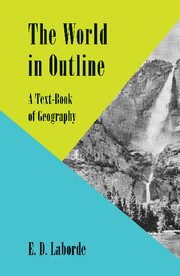Book contents
- Frontmatter
- Preface
- Contents
- PLATES
- PART I EUROPE
- PART II ASIA
- PART III AFRICA
- PART IV NORTH AMERICA
- PART V SOUTH AMERICA
- PART VI AUSTRALIA, NEW ZEALAND, AND THE PACIFIC ISLANDS
- Australia
- Human Geography
- New Zealand
- Human Geography
- The Pacific Islands
- Appendix: An Outline of Physical Geography
- Index of Place-Names
- General Index
The Pacific Islands
from PART VI - AUSTRALIA, NEW ZEALAND, AND THE PACIFIC ISLANDS
Published online by Cambridge University Press: 05 June 2016
- Frontmatter
- Preface
- Contents
- PLATES
- PART I EUROPE
- PART II ASIA
- PART III AFRICA
- PART IV NORTH AMERICA
- PART V SOUTH AMERICA
- PART VI AUSTRALIA, NEW ZEALAND, AND THE PACIFIC ISLANDS
- Australia
- Human Geography
- New Zealand
- Human Geography
- The Pacific Islands
- Appendix: An Outline of Physical Geography
- Index of Place-Names
- General Index
Summary
THE PAPUAN REGION
The rest of the area which we are here considering falls into two parts: the Papuan region and the oceanic islands of the Pacific. The former consists of New Guinea and the numerous other islands, large and small, situated on the continental shelf of Australia. The Wallace Line marks the structural separation from the equally extensive continental shelf of southeastern Asia, but this frontier is of no practical significance, since the flora, fauna, and human inhabitants have found it no obstacle and have crossed it at will in both directions. The islands are the highlands of a submerged region whose instability is still marked by earthquakes and the presence of active volcanoes. The fold lines of the Alps-Himalayan system run through the Lesser Sunda Islands and the southern Moluccas to New Guinea, where the latter line reaches the western end of the Australian arcs.
The islands are all mountainous, the peaks of New Guinea rising to 16,000 feet, and only the largest of them have any considerable areas of lowland.
The region lies within 12° of the Equator and therefore has an equatorial climate tempered by the sea. The statistics for Port Moresby show an equability of temperature known only in this and similar regions, the annual range being 4° F. Thus:
The rainfall is of the equatorial type too, and is mainly influenced by convection; but it is affected in summer by the monsoon winds from the northwest. For some cause that is not yet adequately explained, Timor and the adjacent islands surfer from drought and have a semi-desert vegetation, being as it were an extension of the great Australian desert; but the rainfall increases progressively northwestwards along the Lesser Sunda group. New Guinea and the Moluccas have an abundant precipitation. In New Guinea the constant leaching of the heavy rains has removed from the soil much of the chemicals which cause fertility.
The vegetation, dense in most of the region, shows two tendencies. The islands nearer to Australia are characterised by eucalyptus and acacia, but northwestwards these types gradually change to the fig trees and sago palms of the Asiatic flora.
- Type
- Chapter
- Information
- The World in OutlineA Text-Book of Geography, pp. 487 - 496Publisher: Cambridge University PressPrint publication year: 2013



